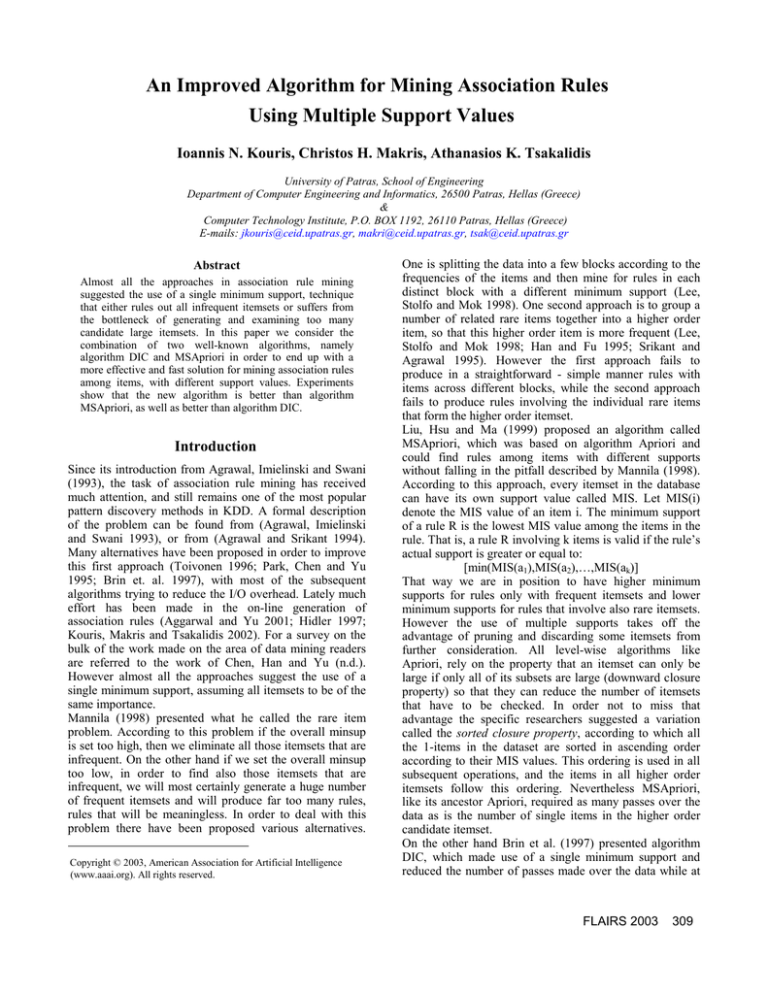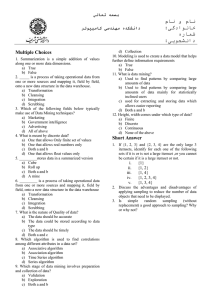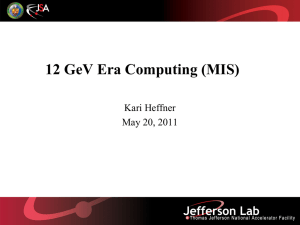
An Improved Algorithm for Mining Association Rules
Using Multiple Support Values
Ioannis N. Kouris, Christos H. Makris, Athanasios K. Tsakalidis
University of Patras, School of Engineering
Department of Computer Engineering and Informatics, 26500 Patras, Hellas (Greece)
&
Computer Technology Institute, P.O. BOX 1192, 26110 Patras, Hellas (Greece)
E-mails: jkouris@ceid.upatras.gr, makri@ceid.upatras.gr, tsak@ceid.upatras.gr
Abstract
Almost all the approaches in association rule mining
suggested the use of a single minimum support, technique
that either rules out all infrequent itemsets or suffers from
the bottleneck of generating and examining too many
candidate large itemsets. In this paper we consider the
combination of two well-known algorithms, namely
algorithm DIC and MSApriori in order to end up with a
more effective and fast solution for mining association rules
among items, with different support values. Experiments
show that the new algorithm is better than algorithm
MSApriori, as well as better than algorithm DIC.
Introduction
Since its introduction from Agrawal, Imielinski and Swani
(1993), the task of association rule mining has received
much attention, and still remains one of the most popular
pattern discovery methods in KDD. A formal description
of the problem can be found from (Agrawal, Imielinski
and Swani 1993), or from (Agrawal and Srikant 1994).
Many alternatives have been proposed in order to improve
this first approach (Toivonen 1996; Park, Chen and Yu
1995; Brin et. al. 1997), with most of the subsequent
algorithms trying to reduce the I/O overhead. Lately much
effort has been made in the on-line generation of
association rules (Aggarwal and Yu 2001; Hidler 1997;
Kouris, Makris and Tsakalidis 2002). For a survey on the
bulk of the work made on the area of data mining readers
are referred to the work of Chen, Han and Yu (n.d.).
However almost all the approaches suggest the use of a
single minimum support, assuming all itemsets to be of the
same importance.
Mannila (1998) presented what he called the rare item
problem. According to this problem if the overall minsup
is set too high, then we eliminate all those itemsets that are
infrequent. On the other hand if we set the overall minsup
too low, in order to find also those itemsets that are
infrequent, we will most certainly generate a huge number
of frequent itemsets and will produce far too many rules,
rules that will be meaningless. In order to deal with this
problem there have been proposed various alternatives.
Copyright © 2003, American Association for Artificial Intelligence
(www.aaai.org). All rights reserved.
One is splitting the data into a few blocks according to the
frequencies of the items and then mine for rules in each
distinct block with a different minimum support (Lee,
Stolfo and Mok 1998). One second approach is to group a
number of related rare items together into a higher order
item, so that this higher order item is more frequent (Lee,
Stolfo and Mok 1998; Han and Fu 1995; Srikant and
Agrawal 1995). However the first approach fails to
produce in a straightforward - simple manner rules with
items across different blocks, while the second approach
fails to produce rules involving the individual rare items
that form the higher order itemset.
Liu, Hsu and Ma (1999) proposed an algorithm called
MSApriori, which was based on algorithm Apriori and
could find rules among items with different supports
without falling in the pitfall described by Mannila (1998).
According to this approach, every itemset in the database
can have its own support value called MIS. Let MIS(i)
denote the MIS value of an item i. The minimum support
of a rule R is the lowest MIS value among the items in the
rule. That is, a rule R involving k items is valid if the rule’s
actual support is greater or equal to:
[min(MIS(a1),MIS(a2),…,MIS(ak)]
That way we are in position to have higher minimum
supports for rules only with frequent itemsets and lower
minimum supports for rules that involve also rare itemsets.
However the use of multiple supports takes off the
advantage of pruning and discarding some itemsets from
further consideration. All level-wise algorithms like
Apriori, rely on the property that an itemset can only be
large if only all of its subsets are large (downward closure
property) so that they can reduce the number of itemsets
that have to be checked. In order not to miss that
advantage the specific researchers suggested a variation
called the sorted closure property, according to which all
the 1-items in the dataset are sorted in ascending order
according to their MIS values. This ordering is used in all
subsequent operations, and the items in all higher order
itemsets follow this ordering. Nevertheless MSApriori,
like its ancestor Apriori, required as many passes over the
data as is the number of single items in the higher order
candidate itemset.
On the other hand Brin et al. (1997) presented algorithm
DIC, which made use of a single minimum support and
reduced the number of passes made over the data while at
FLAIRS 2003
309
the same time kept the number of itemsets that have to be
checked low as compared to sampling techniques
(Toivonen 1996). The main idea of this algorithm was to
start counting any itemset as soon as it is suspected to be
large instead of waiting until all of its subsets are counted
through all the transactions. According to Brin, DIC is
compared to a train running over the data with stops at
intervals M transactions apart. At every stop of the train
some new itemsets get on the train (start to be counted),
while others get of (stop to be counted). What this
approach fails to approximate is that not all passengers are
the same. Some passengers are first class passengers and
thus need some extra attention, while some others are the
economy class. Every itemset that gets on the train at any
stop is presumed to be the same as all the others, or in
other words to have the same support threshold as all the
others. What we try to manage is to incorporate the
philosophy of the multiple support values introduced by
Liu, Hsu and Ma (1999), into the procedure proposed by
Brin et al. (1997) and end up with an even faster and more
efficient algorithm for mining association rules with
multiple minimum supports.
every itemset we are counting against its MIS value. If its
counter is larger or equal to its MIS value then its state is
changed into DS – Dashed Square (Figure 1, snap 2).
When an itemset has been counted through all the
transactions we check again its counter against its MIS
value. If its state was DC – Dashed Circle, and its counter
is finally equal or larger than its MIS value we change its
state to SS – Solid Square. If its state was DS – Dashed
Square, we simply change it to SS – Solid Square (Figure
1, snap 3).
Algorithm KTM
Every itemset in our database is marked with a different
state. Apart from the four states that were used also by the
DIC algorithm, we introduce two additional states for our
purposes. So our algorithm marks overall the itemsets in
six different possible ways, which are:
Dashed Circle (DC) – suspected small itemset – an itemset
we are still counting that its count is bellow its MIS
value– also the initial state of all itemsets.
Solid Circle (SC) – confirmed small itemset – an itemset
we have finished counting and its count is bellow its
own MIS value as well as bellow the MIS value of the
item before it.
Dashed Square (DS) – suspected large itemset – an
itemset we are still counting but its count already
exceeds its MIS value.
Solid Square (SS) – confirmed large itemset – an itemset
we have finished counting through all the transactions
and that exceeds its MIS value.
Dashed Diamond (DD) – itemset which we confirmed that
its count is bellow its own MIS value but above the MIS
value of the item before it in the MIS ordering, and has
not yet generated its corresponding candidate itemsets.
Solid Diamond (SD) – itemset that we confirmed that its
count is bellow its own MIS value but above the MIS
value of the item before it in the MIS ordering and that
has generated its corresponding candidate itemsets.
Every 1-itemset begins to be counted with its state DC –
Dashed Circle, except from the empty itemset, which is
marked immediately with its state solid box (Figure 1,
snap 1). After M transactions, where M is the number of
transactions that have to be read before our train
(algorithm) makes its first stop, we check the counter of
310
FLAIRS 2003
Figure 1: The running of the KTM algorithm
If its counter remains lower than its MIS value and it is a
1-itemset we now check it against the MIS value of the
item before it in the MIS ordering. If it is also bellow the
MIS value of the item before it, we then change its state to
SC – Solid Circle. If on the other hand its counter is equal
or over the MIS value of the item before it, we change its
state to DD – Dashed Diamond (Figure 1, snap 3), and
begin generating all candidates from it. This state is not
preserved long since after this itemset has generated all
possible candidate itemsets we change its state to SD –
Solid Diamond (Figure 1 snap 4). The only difference
between the two states is that an itemset with state SD has
generated all possible candidate itemsets from it. The
reason we added two states, Dashed Diamond - DD and
Solid Diamond – SD instead of just one (state DD –
Dashed Diamond) was because we wanted to keep our
algorithm from producing new candidates at every stop.
Our algorithm terminates upon the absence of any dashed
itemset.
If any immediate superset of a 1-itemset stated DS –
Dashed Square, has all of its subsets as solid or dashed
squares, we make its state DC – Dashed Circle and begin
counting it (Figure 1 snaps 2 & 5). This procedure is
somewhat different for 1-itemsets which are stated DD –
Dashed Diamonds in that we generate supersets from them
by using the 1-itemset stated DD and any 1-itemset stated
DS – Dashed Square, or SD – Solid Square which is also
before it in the MIS ordering (Figure 1 snap 4 where we
generated the candidate itemset <1,3> only and not also
<3,4>). Also the order of every new itemset is preserved,
by putting first the 1-itemset that has the lowest MIS value,
and then all the other items sorted ascending by their MIS
values.
If any immediate superset of a k-itemset ( k ≥ 2 ) stated
DS – Dashed Square has all of its subsets as solid or
dashed squares, we make its state DC – Dashed Circle and
begin counting it. There is however one exception when a
subset of an itemset is not large (i.e. is not stated DS or
SS), and nevertheless the candidate superset cannot be
pruned (In Figure 1, snap 4 superset <1,3,4> is generated
although subset <3,4> is not large). This case arises when
the subset does not contain the first item of the superset
(there is always one such subset) and we are not sure that
the MIS value of the first item is not the same as that of the
second item.
As we can easily understand only 1-itemsets can be stated
DD or SD, since we keep an MIS ordering only for those
itemsets. All the other higher order itemsets can be of state
DC, DS, SS and SC.
Upon termination of the algorithm we end up with an
itemsets lattice like the one shown in Figure 2, with the
empty itemset at the bottom and the set of all items at the
top. The itemsets that are not marked with any state at all
(i.e. were never counted) are nevertheless shown here for
the ease of representation.
Item ordering
The ordering of the items in the data structure plays an
essential role in both algorithms, each for its own
purposes. In this section we show that the ordering that we
apply serves both algorithms and results in a more efficient
combined algorithm.
Liu, Hsu and Ma (1999) proposed a sorting of the items
according to their MIS values in ascending order in order
to satisfy what they called the sorted closure property. Brin
et al. (1997) on the other hand used one single minimum
support, which satisfied the downward closure property,
but brought up the subject of how the items should be
ordered in the data structure used for counting. According
to Brin, having the items that occur in many itemsets to be
last in the sort order of the items, and the items that occur
in few itemsets to be last accomplishes more efficient
counting. The specific researchers tried to apply an item
reordering technique, whose results were rather
disappointing, since the reordering played a negligible role
in the overall performance, whereas sometimes it had the
complete opposite effect, ordering the items completely
reversal. The problem is especially apparent in datasets
that are highly skewed, and localized changes or
characteristics in data can have completely unpredictable
results. The ordering that we propose in our algorithm first
of all satisfies the sorted closure property suggested by
Liu, Hsu and Ma (1999). Furthermore since according to
this ordering the most frequent items are stored last in the
order and the least frequent are stored first, we accomplish
more effective counting, avoid the overhead incurred due
to the re-sorting proposed in the work of Brin et al. (1997),
and finally as shown in the final section, for highly skewed
datasets our algorithm outer performs DIC.
Figure 2: An itemsets lattice
The Data Structure
The data structure used by our algorithm is exactly like the
hash tree used in DIC with a small but very significant
difference. In every node of the tree we store also the
corresponding MIS value of the specific node. This means
that since we do not have a common support threshold for
every itemset in the tree, each itemset must have its own
support value. The MIS values for the 1-itemsets are
assigned manually by the user, and from that point after
the program itself assigns the MIS values to every node
automatically. This step is given bellow:
1 for every itemset c=<c.item1, c.item2,…., c.itemk> that we begin counting
2 select c.item1
c.MIS= c.item1.MIS
3
Basically in every itemset that becomes a candidate (i.e. is
stated DC) and starts to be counted we take the first item,
which also has the lowest MIS value from all the others,
and assign to the itemset this MIS value. In Figure 3 we
present the symbols for the various itemset states, the
transitions among the different states and finally when
should these transitions occur. Managing transitions
among all these states (from active to counted and from
small to large) and detecting when these transitions should
occur becomes a rather complicated task.
FLAIRS 2003
311
itemset.count<itemset.MIS &
itemset end counting
DC
itemset.count>=itemset.MIS
itemset.count<itemset.MIS &
itemset.count>=(itemset-1).MIS
SC
itemset.count>=itemset.MIS
& itemset end counting
DS
DD
itemset.count<itemset.MIS &
itemset.count>=(itemset-1).MIS &
itemset generated all candidates
SS
SD
Figure 3: The transitions among the different states
Performance Comparison
In this section we compare our proposed method with
algorithm MSApriori as well as with algorithm DIC. The
experiments were run on a Celeron 333MHz PC, with
128MB of main memory, under the Windows 98 operating
system.
Experiments with synthetic data
In order to carry out experiments with synthetic data we
used the data generator1, which is very well documented in
(Agrawal and Srikant 1994). As stated by Liu, Hsu and Ma
(1999) in the comparison of MSApriori to algorithm
Apriori, as far as the synthetic data is concerned the time
required by algorithm MSApriori is roughly the same as
that needed by algorithm Apriori since the database scan
dominates the computation. So we compared our algorithm
directly to algorithm Apriori. The number of candidate and
large itemsets are exactly the same for both algorithms and
hence are not shown here.
In order to assign MIS values to the items in the data set
we used the same method used by Liu, Hsu and Ma
(1999), and more specifically we used the following
formulas:
{
MIS ( i ) =
M (i )
M ( i ) > LS
LS
otherwise
where
M ( i ) = βf ( i )
http://www.almaden.ibm.com/cs/quest/syndata.html
312
FLAIRS 2003
Execution time (%)
100%
80%
60%
40%
Apriori
KTM (LS=1%)
KTM (LS=2%)
20%
0%
1
5
10
15
parameter 'a' value
20
β =1 / α
Where f(i) is the actual frequency of an item i, LS is the
user specified lowest minimum item support allowed and β
is a parameter controlling how the MIS values for items
should be related to their frequencies.
1
For our experiments we generated a number of data sets to
test our proposed algorithm. All of the datasets had similar
behavior, and so we present only one. However at its
present version our algorithm does not support the
automatic assignment of MIS values, and so everything
had to be done manually. So we tested our algorithm with
sets consisting of just some tenths of distinct items. We
expect our algorithm to perform even better with more
items. The data set shown here is generated using an
average of 10 items per transaction, with 50 items and
100.000 transactions. The step length of our algorithm was
fixed at 20% of the database (i.e. 20.000 transactions).
Figure 4: Comparison of execution times in percentage
In Figure 4 we show the comparison between the
execution times of the two algorithms as a percentage. As
we can see our algorithm manages to reduce the execution
times considerably. For LS=1% our algorithm runs almost
70% faster (for a=1), and for LS=2% almost 60% faster
(for a=1).
Skewed Data
Algorithm DIC as well as our algorithm are both
susceptible to data skew. Since there is no known
generator for generating skewed synthetic datasets, that we
are aware of, we decided to generate some custom data
sets. We begun with a dataset consisting of 5 items and
100.000 transactions and gradually increased the number
of items to 9.
The datasets that we created were so highly skewed that
some itemsets appeared as seldom as only 100 times in a
dataset of 100.000 transactions, all in consecutive
transactions and most of the times at the end of the whole
dataset. This means that sometimes both the algorithms
had to wait until the end of the transaction file in order to
begin counting some items, thus completely missing the
advantage offered by both the algorithms which is starting
to count higher order itemsets early enough in the dataset.
This explains the slightly high times required by both
algorithms. In these series of experiments we did not
include also algorithm MSApriori as it would yield even
higher execution times.
In these experiments, as can be seen also in Figure 5,
algorithm KTM performed better than algorithm DIC in all
cases, reducing the execution times from 2% in the dataset
with 5 items to almost 10% in the dataset with 9 items and
thus confirming what we have proposed previously.
Improvement KTM vs. DIC
5
Dataset
4
3
2
1
0
2
4
6
8
10
Percentage (%)
Figure 5: % Improvement of execution time
Conclusions and Future work
In the future we would like to run more extensive
experiments in order to test the behavior of our algorithm.
We would like to experiment more with features like the
step length, the minimum confidence as well as with more
distinct items. We would also like to test it with real data,
preferably from a retail company.
References
Aggarwal, C.C. and Yu, P.S. 2001, ‘A New Approach to
Online Generation of Association Rules’, IEEE
Transactions on Knowledge and Data Engineering.
Volume 13, No 4,pp. 527-540.
Agrawal, R., Imielinski, T. and Swani, A., 1993, ‘Mining
association rules between sets of items in very large
databases’, Proc. ACM SIGMOD Conf. Management of
Data, pp.207-216.
Agrawal, R. and Srikant, S., 1994, ‘Fast Algorithms for
Mining Association Rules in Large Databases’, Proc. of
the 20th International Conf. on Very Large Data Bases..
Agrawal, R. and Srikant, S., 1995, ‘Mining Sequential
Patterns’, Proc 11 Int’l Conf. Data Eng., pp.3-14.
Brin, S., Motwani, R, Ullman, J.D. and Tsur, S., 1997,
‘Dynamic Itemset Counting and Implication Rules for
Market Basket Data’. Proceedings of the ACM SIGMOD,
pp. 265-276.
Chen, M.S., Han, J. and Yu, P.S., ‘Data Mining: An
overview from Database Perspective,’ IBM Research
Report RC 20556
Han, J. and Fu, Y., 1995, ‘Discovery of multiple-level
association rules from large databases.’ VLDB-95.
Hidler, C., 1997, ‘Online Association Rule Mining’ Proc.
ACM SIGMOD Int’l Conf. on Management of Data, ACM
Press, New York, pp.171-182.
Kouris, I.N., Makris, C.H., and Tsakalidis, A.K., 2002,
‘On-Line Generation of Association Rules using Inverted
File Indexing and Compression’, In Proc. IADIS Int’l
WWW/Internet 2002 Conference, Lisbon, Portugal.
Lee, W., Stolfo, S. J., and Mok K. W., 1998, ‘Mining audit
data to built intrusion detection models.’ KDD-98.
Liu, Bing, Hsu, Wynne and Ma, Yiming, 1999, ‘Mining
Association Rules with Multiple Minimum Supports’.
KDD-99.
Mannila, H., 1998, ‘Database methods for Data Mining’
KDD-98 tutorial.
Park, J.S., Chen, M.S. and Yu, P.S., 1995, ‘An Effective
Hash Based Algorithm for Mining Association Rules’,
Proc. 1995 ACM SIGMOD Int’l Conf. Management of
Data, pp. 175-186.
Srikant, R. and Agrawal, R., 1995, ‘Mining Generalized
Association Rules’, Proc 21st Int’l Conf. Very Large
Databases.
Toivonen, Hannu, 1996, ‘Sampling Large Databases for
Association Rules’. In Proc. of the 22nd Int’l Conf. on
Very Large Data Bases, Mumbai (Bombay), India, pp.134145.
FLAIRS 2003
313






